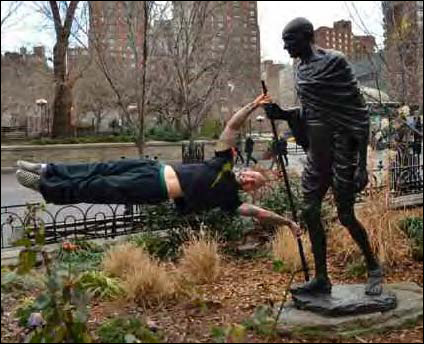
“Strength does not come From physical capacity. It comes From an indomitable will”
-Gandhi

When I was first starting out as a trainer, I remember having a conversation with a client about whether or not a one arm pull-up was possible. We wound up concluding that the only way it could be done was with the other hand holding the wrist of the primary arm. I often look back and laugh about that conversation now. Boy were we wrong!
Of course, most of the time when you hear someone speak of their ability to do a one arm pull-up, what they are actually bragging about is just that (more of what you might call a one-handed pull-up). Let’s be clear right off the jump that, while a somewhat impressive feat on it’s own, this is not a true one arm pull-up. In fact, anyone who can do about ten pull-ups and has decent grip strength will be able to pop off a couple of one handed pull-ups without much trouble.
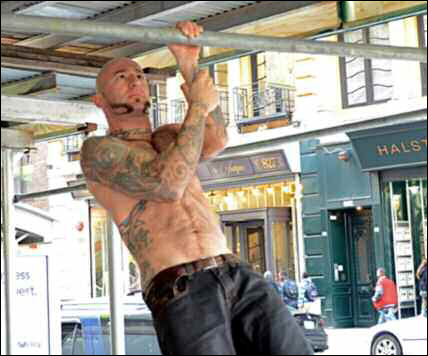
A one handed pull-up, not to be confused with a true one arm pull-up
I’ll never forget the first time I saw someone do a legit one arm pull-up. It was in Tompkins Square Park (of course!) in the summer of 2007. Though I’d never seen one before that day, I’m sure people have been doing them for a long, long time - just not that many people. The statistic I’ve often heard is that only one in 100,000 men can perform this feat, but I think it’s within the potential of any man to do at least one rep. The problem is that most people lack the dedication and patience to ever get close to their full potential.
The one arm pull-up is the single hardest pull-up variation I know. That’s why I saved it for the end. A few freaks of nature might be able to pull one of these off without much specific training, but the rest of us are looking at a solid year of dedicated training even once you can do lots of standard pull-ups. Be prepared to fail at this move for a very long time before you get it.
Though I’ve been training one arm pull-ups on and off for five years, they remain a challenge. Some days I can bang out a couple one arm chin-ups without too much trouble, other days I struggle to get even one decent rep. The one arm pull-up is an elusive enigma that reminds me to keep training hard.
Like we discussed back in Chapter One, a pull-up is done with a pronated (overhand) grip, while a chin-up implies a supinated (underhand) grip. When you do a one arm pull-up, however, there’s a certain amount of rotation that’s virtually unavoidable. This is why many of the people who can perform this feat will wind up bringing the bar towards the shoulder opposite their pulling arm. For me, the disparity between overhand and underhand grips seems negligible. I’ve done so many reps of different kinds of pull-ups over years that I may have just evened it out. Besides, when someone is strong enough to pull their chin over the bar with just one arm, they’ve earned my respect. Nitpicking about their hand position seems pointless.
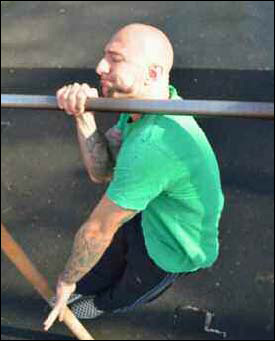
When performing a one arm pull-up, a certain amount of rotation is virtually unavoidable.
Only once you can perform at least fifteen consecutive dead hang pull-ups should you even consider training for this feat. The one arm pull-up is more advanced than any of the other exercises in this book. It’s the ultimate pull-up - that’s why it gets it own chapter! Keep that in mind when you begin your journey. It’s going to be a long one.
One more word of caution before we begin here; tendinitis is a bitch, so back off if you start to get pain in or around your elbows or shoulders. Rest is a very important part of strength training. Remember that your tendons and other connective tissue also need time to adapt to the demands of the one arm pull-up. I can’t stress enough the importance of taking your time with this move. Focus on the process.
Training for a one arm pull-up is a lot like starting over from scratch. In fact, the training is pretty much the same - except you do everything with just one arm! Just like a raw beginner learning to do a two arm pull-up, you’ll need to go slowly and manage your expectations. Needless to say, the first thing is to get a solid single arm hang. Try to build to at least 30 seconds (ideally longer) before you move on to the next phase. I also recommend practicing one arm hanging leg raises to get a feel for the stability (or lack thereof). Just like the two arm hangs, remember to pull your shoulder down into your socket and engage your stabilizer muscles.
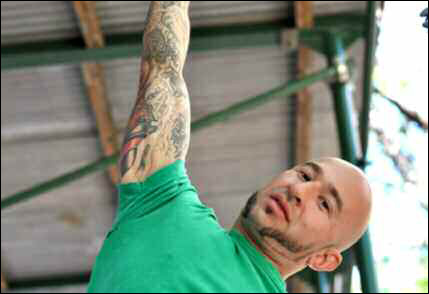
Performing a flex hang with one arm is the next step towards doing a one arm pull-up. Pull yourself up using both arms, then try to stay up while you take one hand away. Squeeze with everything you got! Notice how I am keeping my entire body engaged in the photo to the right.
It’s important to note that for all my talk about the negligible disparity between over and underhand grips for well conditioned individuals, the one arm flex hang is best practiced underhand. A supinated grip allows you to keep your arm closer to the middle of your body with your forearm tight against your chest, allowing you better leverage to hold the position. Though I can do an overhand pull-up with one arm, holding the top position for any length of time is much harder. If you can hold an overhand grip one arm flex hang for more than a second or two you must be wickedly strong - I’d love to train with you some time!
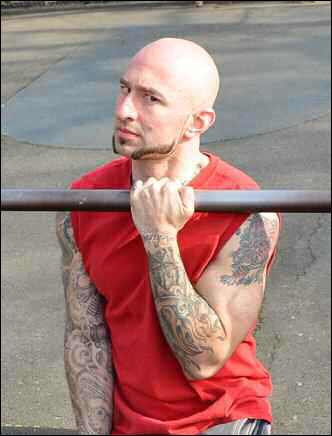
It is best to practice the one arm flex hang with an underhand grip.
We’ve been over this concept a few times by now. The idea here is to keep your body tight and controlled while slowly lowering yourself down from a one arm flex hang. Be prepared that the first time you try to do a one arm negative you will drop very quickly. When starting out, don’t even think of it as a negative, think of it as just trying to keep yourself up. Gravity takes care of the rest. Eventually, try working up to the point where you can make a one arm negative last for ten seconds or longer.
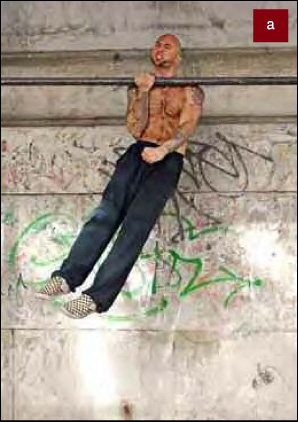
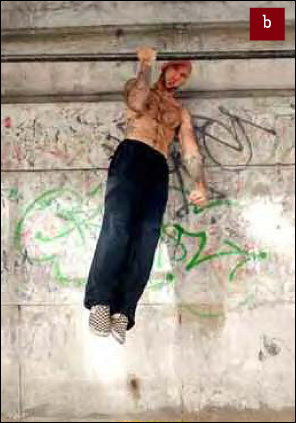
Keep your body tight and controlled while slowly lowering yourself down from a one arm flex hang.
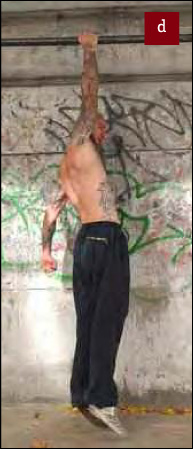
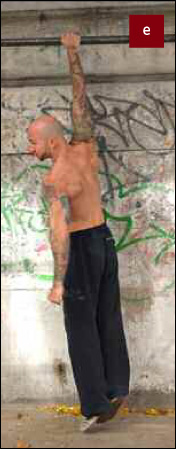
Eventually, try working up to the point where you can make a one arm negative last for ten seconds or longer.
Using your free arm to assist your primary arm is a cornerstone of one arm pull-up training. When you’re learning to do a regular pull-up, you might need a spotter to assist you, but when you’re learning the one arm pull-up, you can be your own spotter! As I mentioned in Chapter Four, an archer pull-up is one type of self assisted one arm pull-up, though there are other ways of achieving the same effect. One way is to practice the one handed pull-up we discussed at the beginning of this chapter.
As with the archer pull-up, when using a one handed pull-up as a means to work towards a true one arm pull-up, try to do as much of the work as possible with your primary arm. Also keep in mind that the further your assisting hand gets from your wrist the less help it can give you. So if you can do more than about 5 reps with your hand on your wrist, try moving your hand down to the bottom of your forearm. When that gets easier, the next step is to place your free hand on your opposite shoulder.
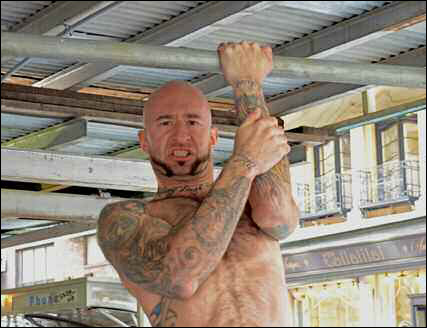
The further your assisting hand gets from your wrist the less help it can give you.
This is a nice precursor to the one arm pull-up for the same reason that Australian pull-ups can be a gateway to pull-ups – your feet are on the ground! When attempting a one arm Australian pull-up, concentrate on engaging your abs and your back muscles–focus on using all of your muscles and not just your bicep strength. Remember that when you do a one arm Australian, it’s natural for your body to roll a little bit in the direction of your pulling arm. As always, remember to squeeze your whole body tight!
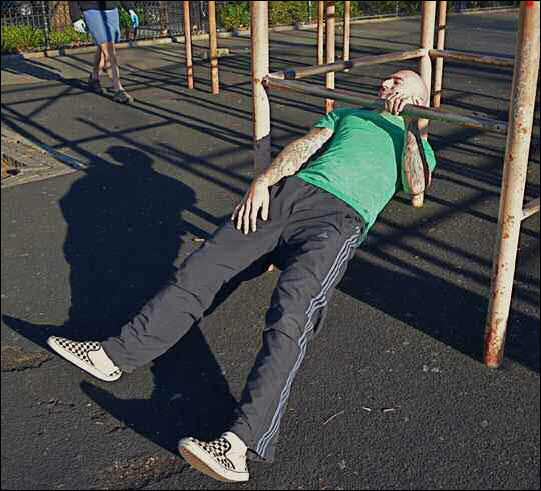
As always, remember to squeeze your whole body tight!
When you do a one arm pull-up, your opposite arm shouldn’t be touching your primary arm in any way, but that doesn’t mean it can’t help with the movement. Remember our talk about counter balance in Chapter Seven? Reaching your free arm away from your body can change the balance and make the one arm pull-up slightly more manageable. You might find it helpful to reach your legs away as well.
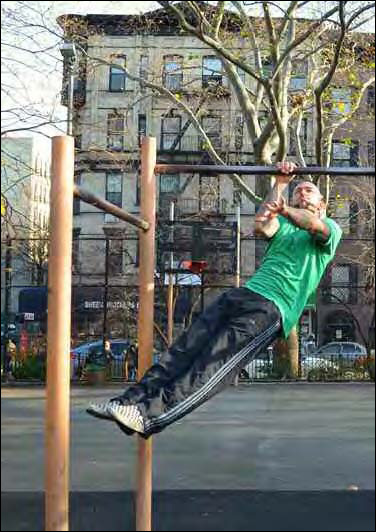
Reaching your free arm away from your body can change the balance and make the one arm pull-up slightly more manageable.
Like most types of pull-ups, the hardest part of a one arm pull-up is the last couple of inches. Struggling to get your chin all the way past the bar can make an inch feel like a mile. If you are having difficultly here, practicing partial reps can be helpful.
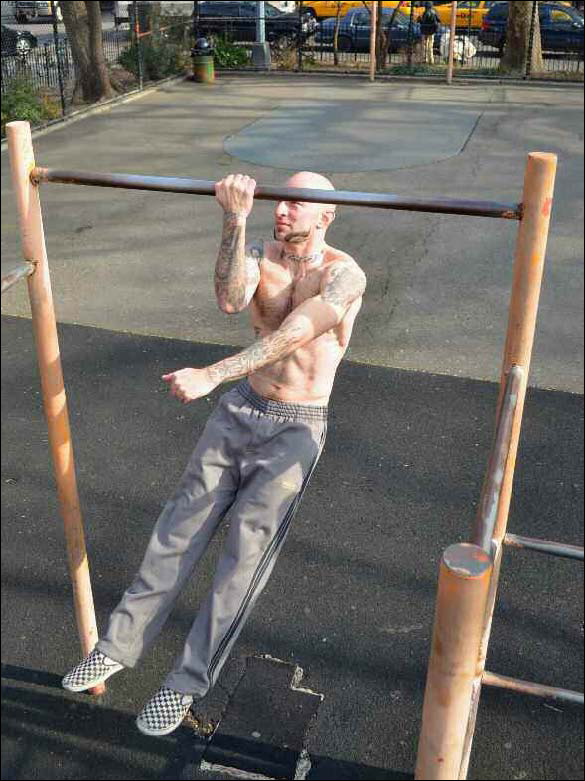
Start from a one arm flex hang and try to lower yourself half way down (or even just a quarter of the way) then pull back to the top to get extra practice on the final few inches of the range of motion. One arm headbanger pull-ups can also be helpful for increasing power on the last few inches.
While Western thinking tends to get caught up in goals and desires, Zen is all about the present. I tend to agree with this idea of staying in the moment, especially when it comes to training. When training for the one arm pull-up, try to avoid getting too hung up on the end result. Focus on the present and do your flex hangs and negatives with everything you’ve got - they’re very hard exercises in their own right! The journey is the only way to get to the destination, so be there for it or you might miss it altogether. Remember, good things come to those who train.
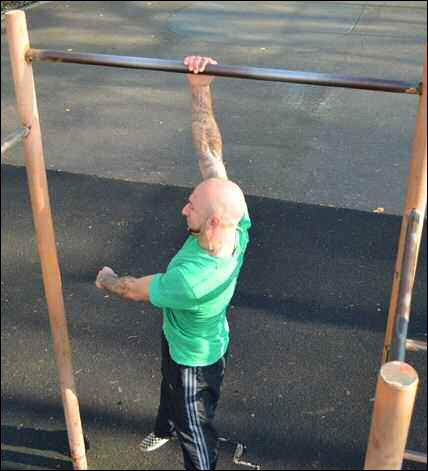
The journey is the only way to get to the destination, so be there for it or you might miss it altogether.